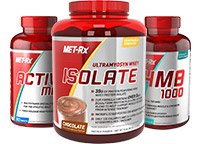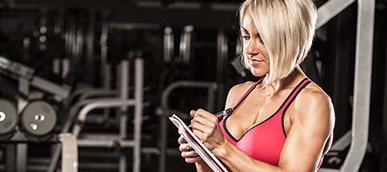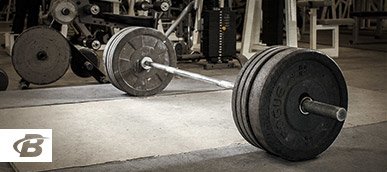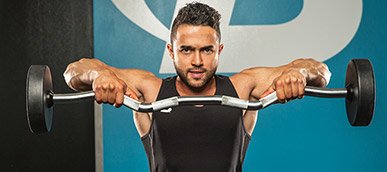
10 Beginner's Fitness Mistakes You'll Never Make Again
Getting ready to transform, or just getting started in the wide world of fitness? Set off on the right foot and learn how to overcome 10 common mistakes most beginners face!
I love the old saying, "If it were easy, everyone would do it." It can be applied to countless instances in life, but it rings especially true when talking about smart exercise and proper nutrition.
It's a great day when someone decides to buck the statistics, reject the easy path, and throw themselves into the challenge of getting strong and healthy, but that's just the beginning. Building the foundation of a fit life takes weeks—months, even—of hard work, and your enthusiasm can often work against you.
Luckily, there's nothing new under the fluorescent lights of the gym. Every mistake you could possibly make has been made a thousand times before, and you can learn from the past—if you're willing. The following ten mistakes have dashed far too many beginners' fitness dreams on the rocks. But not yours! This time, you're going to recognize these mistakes for what they are and keep sailing right on by.
Mistake 1 Thinking more is better
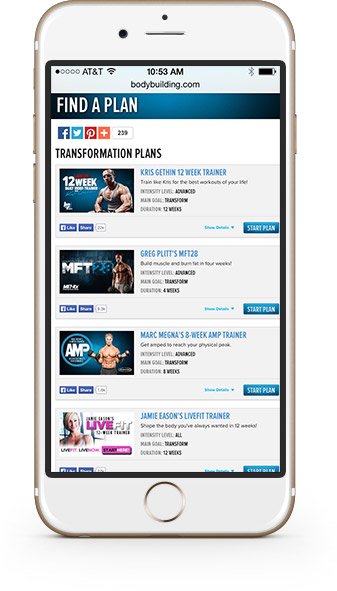
Sometimes, when people begin doing something in the gym, they immediately start looking for ways to do more. More sets, more cardio, more goals, more movements, and more time spent training might sound like things that will help you reach your fitness goals, but the opposite usually ends up being the case.
It's understandable; you've made a commitment to yourself, and you want to make sure you're doing everything you can to live up to it. Plus, if you're like most people, you spend as much time reading about training online as you do actually training. It doesn't take long to see the vast number of things you could be doing, but don't take the bait!
When you're just starting out, your body will respond positively to just about any stimulus. But if you try to force it to adapt to too much at once, you'll hit a wall or injure yourself in no time. Your body, your schedule, and your attention span can only handle so much right now. Respect all three!
The Solution: Quality over quantity. Pick a reasonable program—check out Find a Plan if you need some guidance—and follow it as closely as you can. Don't spend more than 45 minutes in the gym per session. Your goal is to get in, do your workout, and leave. Then, come back and do it again, and again, and again.
Mistake 2 Thinking more cardio equals more fat loss
Many beginners have weight loss—and more specifically, fat loss—as their first priority. That's fine, but how they go about it is usually far too single-minded. Who can blame them? In most gyms, the cardio machines are the first thing you see when you walk in, and everyone who is trying to lose weight seems to be on them. You can break a sweat—while watching TV, of course—and pretend the weight room doesn't even exist.
Does low- and moderate-intensity cardio burn enough calories to help you lose fat? Sure, but it's by no means the most efficient or effective way to achieve this goal. If you took your 45-minute window and devoted 25 minutes of it to strength training and 20 to slightly higher-intensity cardio, you would set yourself up to achieve far more dramatic results far more quickly.
The Solution: Weights for the main course, cardio for dessert. MET-Rx athlete and four-time Figure Olympia champion Nicole Wilkins says, "If you are looking to change the shape of your body, have more definition, and feel stronger, you simply must include weight training."
Muscle burns calories at rest, meaning that for every bit you add, you become a more efficient fat-burning machine. Plus, as you get stronger, you'll find that you can do more work—be it cardiovascular work or your normal daily work—and more work equals more calories burned. There's simply no way around it; you need strength training in your life!
Mistake 3 Giving up before your body has a chance to change
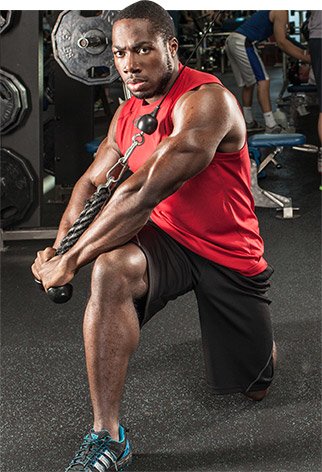
Transitioning from a physically inactive life to an active one is a major change, and to your body, it feels initially like a threat. Often, it can take up to 2-3 months for your body to stop fighting your new habit tooth and nail and start embracing it, in the form of muscle gain and fat loss. Unfortunately, many people give up after around 4-6 weeks—or sooner—if they aren't seeing any major changes in their body.
This is no fun to hear, but it's the truth. And, if you're in a caloric deficit, your body's urge to protect and preserve every calorie is going to be even greater.
The Solution: Be more stubborn than your body. Eventually your body will get the memo, respond to what you're doing in the gym, and begin to understand it can live—and thrive—with what you are putting it through. However, "eventually" is different for each person.
Your body is a high-tech computer, but sometimes it just takes some new software and a little patience to make it run better. Once you've started a program or diet, give yourself at least a couple of consistent months before you make drastic changes.
Mistake 4 Watching the scale like a hawk
The scale is the fitness world's equivalent of the proverbial watched pot that never boils. We've all hopped on the scale at some point in our lives and found ourselves disappointed that even after hours in the gym, multiple times a week, for several weeks, the same number is staring up at us.
When this happens, the thought of throwing the scale through the closest window comes to mind. Well, maybe you should! The number on the scale is just that—a number. It doesn't say anything about lean muscle mass, water weight, or body fat. Heck, even body composition doesn't tell the whole story.
The Solution: Use other measurements of progress. It may not sound scientific, but how you look and feel are probably the best measurements of your progress when you're just starting out. How does your clothing fit? Is it a little looser around the middle or tighter in the sleeves? Progress! What about your workouts—do they feel better? Are certain weights moving more easily? Is your overall energy level improving during the day? That's definitely progress.
For the initial few months of your lifestyle change, trust these as your real measurements. Back them up every once in a while with progress photographs and a body composition test, and only step on the scale once in a blue moon. Most importantly, just keep going back for more. You will change!
Mistake 5 Caring about how much you lift too soon
How much you weigh is a numbers game that can drive you crazy. How much weight you're moving is another. Nobody wants to struggle against an empty bar while the beast on a nearby bench moves more plates than you can count. But throwing your whole body into every repetition trying to get the weight up by any means necessary is bad news. Not only are you begging for an injury, you're also not learning, practicing, and performing the lifts with good form, which are the keys to actually lifting more over time.
The Solution: Start safely. Check your ego at the door. If you can't handle a weight with strict form, lighten the load until you can. Feel the muscle working with each repetition, and treat your training like practice, because that's what it is. Don't just focus on the heaviness of the weights, but on things like how many reps you can perform, or how much total weight you moved in an entire workout. Over time, begin to compete against yourself and your previous bests, not someone else.
Mistake 6 Changing your diet all at once

Some smokers can quit cold turkey—great for them. More often, intense withdrawals and cravings lead them to stick a cigarette in their mouth after just a few days or weeks. The same applies to cleaning up your nutrition. Eliminating everything you're used to eating all at once will have you stalking the fridge like a lion stalking a gazelle—and growling like one. We all know how that nature film ends.
The Solution: Clean up your diet in steps. You probably know what your worst one or two nutrition vices are. Target them first. Once you get through a few weeks without them, remove another one or two bad food choices from your house. Make it a gradual process, and after some time, you won't even miss those foods anymore. When that happens, you'll be on your way to hitting your goals.
Mistake 7 Guessing how to use equipment
We've all seen videos of the dude at the gym trying to do an exercise but somehow looking like he's doing dance moves from "Saturday Night Fever." None of us want to be him, but on the other hand, few of us are willing to set our ego aside—remember Mistake 5?—and ask for some much-needed guidance. This is how injuries happen, both to us and to the innocent bystanders around us.
The Solution: Ask for help! No matter where you live and train, there are people who can help you exercise better. They can be trainers, fellow gym-goers, and knowledgeable acquaintances. The important thing is that they've been where you are, and they've done what you're trying to do. Sometimes you have to pay for their guidance, but often, people are more than willing to give you a game-changing piece of wisdom for free. This can't be emphasized enough: If you don't know, ask.
Mistake 8 Following advanced routines
If Mistake 7 made you say, "But everything in my routine is something I don't know how to do!" then ask yourself: Is your routine really yours? Too often, beginners fall into the trap of thinking that the advanced routines they see in magazines or online are somehow better than simple ones.
Of course world-class physique athletes can be great inspirations, but for the rest of us, their workouts can be a recipe for burnout and injury. Elite athletes train tirelessly alongside elite coaches, pursue incredibly specific goals, and have a foundation of muscular development that the rest of us simply don't.
The Solution: Start with the fundamentals. Don't try to "live up to" a program. Focus on learning how to safely perform fundamental movements like squats, presses, rows, and lunges, and only add volume and intensity when you're ready. If you don't know when you're ready to mix things up, have someone more knowledgeable help you figure it out. Take as much time as you need so you can milk those legendary "beginner's gains" for all they're worth!
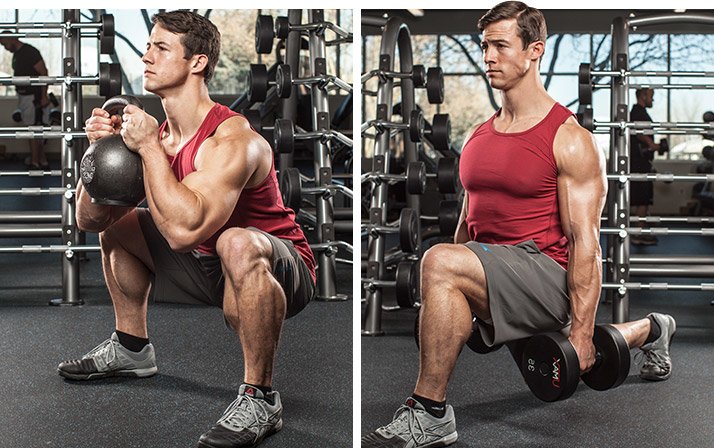
Mistake 9 Expecting supplements to do the work for you
Outlandish claims about fat-loss supplements these days are the norm, not the exception. In ads, on TV shows, and in articles that cite studies you've never read, it can seem like a total life transformation is just one pill away. Guess what? It's not. The answer always has been, and always will be, what you do in the gym and what's on your plate.
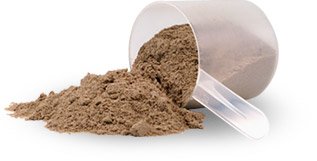
The Solution: Stick to protein and nutrients for now. One thing that many, many studies have agreed on is that adding protein to your diet can help you achieve a healthier body composition, particularly alongside a consistent training program. When you're in a caloric deficit, this is even more pronounced. A great-tasting, affordable protein to help you increase your protein intake is all you need. If you want more supplements, consider a multivitamin first. Keep it simple, so it's simple for you to keep doing it!
Mistake 10 Focusing only on big goals
Don't get me wrong; goals are important. Knowing that you want to lose a certain amount of fat, gain a certain amount of muscle, or reach a certain benchmark on a big lift is great. Those are quantifiable objectives you can pursue and track over time. But if you're only in it for the goals, you might be setting yourself up for massive disappointment. After all, we often learn that our initial lofty goals were ill-advised. So ask yourself: What happens then?
The Solution: Make consistency your primary goal. I've got a goal for you: Start a 12-week program, and then finish it. Which one it is doesn't matter all that much, as long as it's not too incredibly difficult or advanced.
Along the way, make it a point to learn everything you can about exercise, muscle, and nutrition. Become fascinated by your body and what it's capable of. Become an aficionado of the fit life, and see how important, life-changing, and meaningful it can be. When you're ready, your next goal will come into focus. When that happens, attack it with all you've got!
Recommended Articles
Reach Your Fitness Goals In 7 Easy Steps
Dream big—and achieve it! Follow these key steps on how effective goal setting can turn your dreams into reality.
Top 5 Home Workouts From The Forum!
Not everyone can afford to join a gym or afford to purchase multiple machines for a home gym. So how do you get in a good workout without the fancy equipment? See what the Bodybuilding.com forum has to offer.
6 Mistakes Keeping You From Your Fitness Goals
Want the body of your dreams? Then don't let any of these fitness miscues hold you back any longer!



